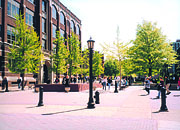
Duquesne University in Pittsburgh features one of the most comfortable urban campuses in the country. The Catholic university enrolls over 9,700 students in a wide variety of liberal arts, science, and professional curricula on undergraduate and graduate levels. Known for innovation and quality, it recently received a designation as one of the "most wired" campuses in the country from a national computer magazine, citing how web access is available in classrooms, offices, and residence halls.
The school has explored comparatively new territory in another area as well - the installation of a campus-wide cogeneration system. The Duquesne University energy project evolved in the mid-1990s as the university confronted a situation of aging chillers at dispersed building locations. These chillers utilized CFCs and, because of low efficiency, were contributing to rising energy expense. The university began seeking a solution that would address each of these problems.
The university had recently entered into a relationship with Noresco (Pittsburgh), an Equitable Resources Company, to supply bulk natural gas to the school. In February 1996, Duquesne expanded the agreement to address other energy and environmental concerns. At that point, planning for a total campus utility infrastructure, to be managed by Noresco, began.
Later signing a 15-year integrated energy services agreement, the university has now essentially outsourced operation of the hvac and electric generation to Noresco while maintaining its ownership and long-term planning role. As is so often the case, Noresco is paid out of the savings over the university's previous energy budgets.
System Details
The centerpiece of the agreement was the development of the Energy Center, which encompassed the cogeneration facility as well as the system operations center and the monitoring points for the gas and electric interconnections. At this location, central electric generation is provided by a 5-mW gas turbine manufactured by Solar Turbines, Inc. This level of generation meets about 95% of the university's needs. The school maintains an interconnection with the electric utility for the requirements and as a system backup. No power is sold back to the utility, and the turbine is controlled to meet native load only.The exhaust steam from the turbine enters a diverter valve, where it is either exhausted to the atmosphere or, more commonly, directed to the steam generator. The steam generator has a nominal steam capacity of 23,000 lb/hr of 125-psig saturated steam at 350°F. In addition to the heat recovery steam generator, steam can be produced by three 600-hp Johnston fire-tube boilers. These supply system steam when the turbine is not running for any reason, as well as when additional steam is needed for peak heating requirements.
In addition to the campus steam heating system, the steam also feeds two 750-ton and one 1,050-ton Horizon two-stage steam absorption chillers, manufactured by The Trane Company (La Crosse, WI). The chillers, designed with anticrystallization logic and variable-speed refrigerant pumps, are provided cooling water by a new Marley four-cell cooling tower. The tower handles cooling flows up to 9,200 gpm.
There is provision for an additional tower cell to handle future expansion, and the cogeneration system was designed for expansion as well. These provisions include a central chilled-water piping system sized for 3,300 tons of cooling, a mountain pad for an additional chiller, and bases and piping ready to accept extra chilled water and condenser pumps.
"This type of cogeneration project is unique in western Pennsylvania," says Mark Johnson, project manager from Noresco. "The Energy Center takes the place of 10 other mechanical rooms. We are generating most of the electricity, but there is a need for a high level of integration with the local utility.
"We were very selective about the design and the type of equipment installed. We have to live with the consequences. The university likes the fact that the project constructor stays on to operate the plant. They knew it was in our best interest to build a reliable and efficient plant."
All Downhill From Here
In the process of development of the Energy Center in 1997, part of a campus parking lot was converted into an enclosed mechanical space for the chillers and auxiliary equipment. Steve Alauzen, a Trane sales representative who was closely involved in the engineering of the project and delivery and installation of the chillers, notes that the sloped nature of the previous parking lot floor presented a challenge. Still..."They used steel rollers under the skids and the whole process went quite quickly," he says. "The sloped floor actually turned out to be an advantage." In all, over $9.5 million was invested by the university and by Noresco in the project. Construction began in February 1997, and the facility went into commercial operation on November 1, 1997. Thus far, feedback has been good. According to Duquesne's facilities director, Gust Flizanes, "The project has been very successful. It was within budget, and we were able to select the right equipment and the right construction team."
Flizanes reflects on the decision to go ahead with the project, rather than continuing to buy electric energy from the utility.
"For this type of arrangement to work, you need the correct set of circumstances," he says. "Everything needs to fit: the proper size facility, the right seasonality, the correct combination of heating, cooling, and electric demand. We spent a long time analyzing before we concluded that this type of system made sense. We needed to take the long-term view. The decisions weren't always clear cut, but I think we did the right thing." ES
